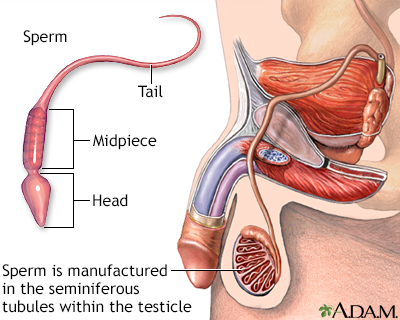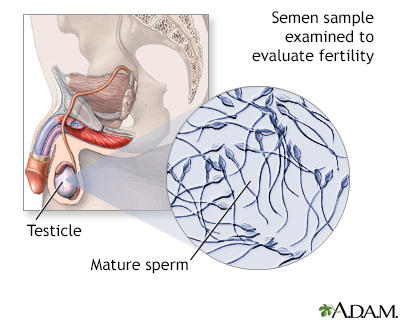Semen analysis
Semen analysis measures the amount and quality of a man's semen and sperm. Semen is the thick, white fluid released during ejaculation that contains sperm.
This test is sometimes called a sperm count.
How the Test is Performed
You will need to provide a semen sample. Your health care provider will explain how to collect a sample.
Sperm release pathway - Animation
The key male reproductive organs include the testes, epididymis, urethra, vas deferens, prostate gland, seminal vesicle, and penis. The testes are composed of coiled structures called seminiferous tubules, which are the sites of sperm production. The structure on top of the seminiferous tubules in the testes is the epididymis. The sperm migrate from of the seminiferous tubules to the epididymis. Within the epididymis, the sperm mature while they are stored in this structure. The ejaculation process begins as the penis fills with blood and becomes erect. With sufficient stimulation, mature sperm travel from the epididymis through the vas deferens, a muscular tube, which propels sperm forward through smooth muscle contractions. The sperm arrive first at the ampulla, where secretions from the seminal vesicle are added. From the ampulla, seminal fluid is propelled forward through the ejaculatory ducts toward the urethra, passing first by the prostate gland, where a milky fluid is added to form semen. Finally, the semen is ejaculated through the far end of the urethra.
Methods for collecting a sperm sample include:
- Masturbating into a sterile jar or cup
- Using a special condom during intercourse given to you by your provider
You should get the sample to the lab within 30 minutes. If the sample is collected at home, keep it in the inside pocket of your coat so that it will stay at body temperature while you are transporting it.
A laboratory specialist must look at the sample within 2 hours of the collection. The earlier the sample is analyzed, the more reliable the results. The following things will be evaluated:
- How the semen thickens into a solid and turns to liquid
- Fluid thickness, acidity, and sugar content
- Resistance to flow (viscosity)
- Movement of the sperm (motility)
- Number and structure of the sperm
- Volume of semen
How to Prepare for the Test
In order to have an adequate sperm count, do not have any sexual activity that causes ejaculation for 2 to 3 days before the test. However, this time should not be longer than 5 days, after which the quality can diminish.
How the Test will Feel
Talk to your provider if you are uncomfortable with how the sample is to be collected.
Why the Test is Performed
Semen analysis is one of the first tests done to evaluate a man's fertility. It can help determine if a problem in sperm production or quality of the sperm is causing infertility. About half of couples unable to have children have a male infertility problem.
Infertility
Infertility means you cannot get pregnant (conceive). There are 2 types of infertility:Primary infertility refers to couples who have not become preg...

The test may also be used after a vasectomy to make sure there are no sperm in the semen. This can confirm the success of the vasectomy.
Vasectomy
A vasectomy is surgery to cut the vas deferens. These are the tubes that carry sperm from the testicles to the urethra. After a vasectomy, sperm ca...

The test may also be performed for the following condition:
- Klinefelter syndrome
Klinefelter syndrome
Klinefelter syndrome, also called 47,XXY, is a genetic condition that occurs in males when they have an extra X chromosome. This can cause problems ...
 ImageRead Article Now Book Mark Article
ImageRead Article Now Book Mark Article
Normal Results
A few of the common normal values are listed below.
- The normal volume varies from 1.5 to 5.0 milliliter per ejaculation.
- The sperm count varies from 20 to 150 million sperm per milliliter.
- At least 60% of the sperm should have a normal shape and show normal forward movement (motility).
Normal value ranges may vary slightly among different laboratories. Talk to your provider about the meaning of your specific test results.
Sperm production - Animation
Sperm are produced, stored, and delivered by the male reproductive system. Here, you can see the parts of the male reproductive system -- the testes, urethra, vas deferens, prostate, seminal vesicle, and penis. The testes contain coiled structures called seminiferous tubules, which are the sites of sperm production. A woman’s ovaries need only produce one egg per month, but a man’s seminiferous tubules produce over 12 billion sperm per month. The structure on top of the seminiferous tubules is the epididymis. The immature sperm migrate there to mature, and then are stored there afterwards. This trip usually takes about 20 days. Before intercourse, the penis fills with blood and becomes erect. Then, with sufficient stimulation, an ejaculatory process begins. Here you can see the mature sperm traveling from the epididymis through the vas deferens, which is a narrow, muscular tube about 18 inches long. Its smooth muscle contractions propel the sperm forward. They arrive first at the ampulla, the widest part of the vas deferens, and then pass into the ejaculatory ducts. Here, a liquid secretion from the seminal vesicles mixes with the sperm. Seminal fluid contains fructose sugar, which the sperm use as fuel. It also has alkalines, which help to counteract the naturally acidic environment of the vagina and uterus so the sperm have a better chance for survival. From there, the liquid mixture is propelled forward through the ejaculatory ducts toward the urethra, passing first through the prostate gland, where milky prostatic fluid is added, forming the substance we call semen. The prostatic fluid helps the sperm swim faster, which is important for getting to the egg cell. Finally, about a teaspoon of semen is ejected out, or ejaculated, through the far end of the urethra at the end of the penis. From the time the sperm leave the man’s body, they have between 12 and 48 hours to find and fertilize the egg cell, assuming an egg is available. Most of the sperm won't make it. Of the 300 million sperm ejaculated, only about 200 or so will survive to reach the egg cell and only one of those will succeed in fertilizing it.
An abnormal result does not always mean there is a problem with a man's ability to have children. Therefore, it is not completely clear how the test results should be interpreted.
What Abnormal Results Mean
Abnormal results may suggest a male infertility problem. For example, if the sperm count is very low or very high, a man may be less fertile. The acidity of the semen and the presence of white blood cells (suggesting infection) may affect fertility. Testing may reveal abnormal shapes or abnormal movements of the sperm.
However, there are many unknowns in male infertility. Further testing may be needed if abnormalities are found.
Many of the causes of male infertility are treatable.
Risks
There are no risks.
Considerations
The following may affect a man's fertility:
- Alcohol
- Many recreational and prescription drugs
- Tobacco
Reviewed By
Sovrin M. Shah, MD, Associate Professor, Department of Urology, The Icahn School of Medicine at Mount Sinai, New York, NY. Review provided by VeriMed Healthcare Network. Also reviewed by David C. Dugdale, MD, Medical Director, Brenda Conaway, Editorial Director, and the A.D.A.M. Editorial team.
Jeelani R, Bluth MH. Reproductive function and pregnancy. In: McPherson RA, Pincus MR, eds. Henry's Clinical Diagnosis and Management by Laboratory Methods. 24th ed. Philadelphia, PA: Elsevier; 2022:chap 26.
Swerdloff RS, Wang C. The testis and male hypogonadism, infertility, and sexual dysfunction. In: Goldman L, Cooney KA, eds. Goldman-Cecil Medicine. 27th ed. Philadelphia, PA: Elsevier; 2024:chap 216.




 All rights reserved.
All rights reserved.